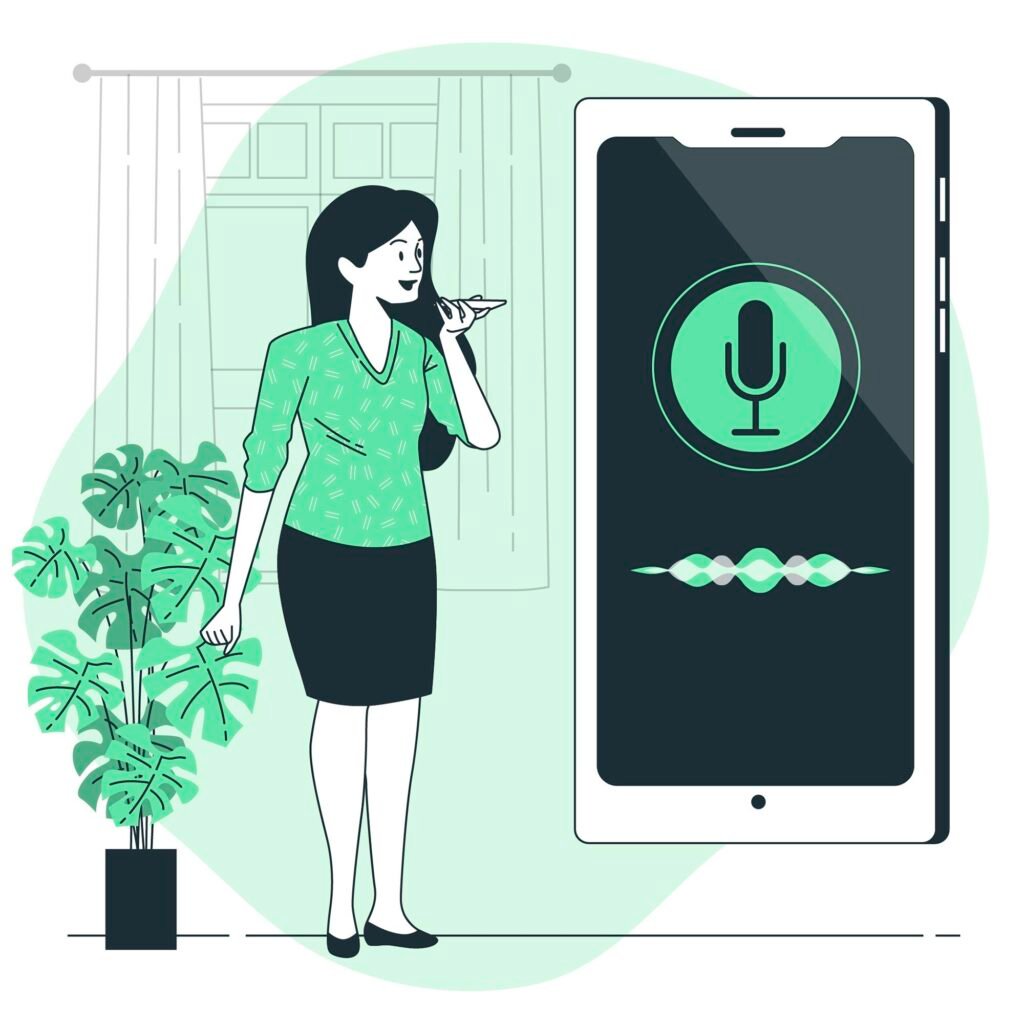How Businesses Leverage the Capabilities of Voice Command Recognition Software
7 Mar 2024
Igor Kelly

Voice assistants are supporting more and more people in their everyday lives. Devices like Siri, Alexa, and Google Assistant are currently experiencing increasing popularity. Their application areas are diverse; they can answer questions about the weather, comment on what is happening in the world, tell a joke, or control smart home devices.
Many businesses have also already reaped the benefits of voice command recognition. Instead of buttons, touchscreens, or keyboards, a voice UI relies on speech recognition software and natural language processing algorithms to interpret and respond to user queries, enabling hands-free experience.
But how do conversational user interfaces actually work? And why can voice assistants react to what we say and understand what we say? We look behind the scenes of voice authentication and discover how virtual assistants drive sales and improve daily workflow in various industries.
Understanding Voice Command Recognition Software
Speech recognition was originally intended primarily for people with physical limitations — or as an expensive dictation aid. It was often hidden in the operating systems’ operating systems and usually worked rather poorly — or was very expensive. With increasing broadband networking, strong computing power, modern machine learning, and the emergence of smartphones and smart home systems, speech recognition was completely redesigned.
Today, voice recognition command software is a technology that enables computers and devices to interpret and respond to spoken commands from users. It uses sophisticated algorithms and machine learning techniques to convert spoken language into text, understand the meaning of the text, and execute corresponding actions or tasks.
1. Virtual assistants (e.g., Siri, Google Assistant): Virtual assistants are software agents that can perform tasks or services for an individual based on spoken commands or queries.
How it works: Users activate the virtual assistant by saying a wake word (e.g., «Hey Siri» or «Okay Google»). The device then records the user’s voice and transmits it to a server for processing. The server uses natural language understanding and machine learning algorithms to interpret the command and execute the appropriate action, such as setting reminders, sending messages, or searching the web.
2. Voice-activated systems (e.g., Amazon Echo, smart TVs): These systems allow users to control devices, appliances, or software using spoken commands.
How it works: These systems have microphones that constantly listen for a wake word (e.g., Alexa for Amazon Echo). Once the wake word is detected, the device begins recording the user’s command. The recorded audio is then processed locally or sent to a cloud server for interpretation. The system executes the desired action based on the interpreted command, such as playing music, adjusting the thermostat, or turning off lights.
3. Interactive voice response (IVR) systems (e.g., automated customer service lines): IVR systems interact with callers through spoken words and keypad inputs, allowing them to navigate menus and perform tasks without human assistance.
How it works: When a caller contacts a company’s IVR system, they are greeted with pre-recorded messages and prompts. The caller responds by speaking or using the keypad to select options. The IVR system uses speech recognition technology to understand the caller’s responses and route them to the appropriate destination or provide relevant information, such as account balances or order statuses.
4. Speech-to-Text applications (e.g., Dragon NaturallySpeaking, Otter.ai): These types of apps convert spoken language into written text, allowing users to dictate documents, transcribe conversations, or generate subtitles.
How it works: Users speak into a microphone connected to their device or smartphone. The speech recognition software processes the audio input, breaking it down into phonemes and analyzing patterns to identify words and sentences. The recognized text is then displayed in real time or saved as a document. Advanced speech-to-text applications incorporate machine learning algorithms to improve accuracy over time and adapt to individual speech patterns and accents.
The Mechanics Behind Voice Command Recognition
Now, let’s delve into the technology that powers voice recognition software. To enable an intuitive user experience, the following three components are required:
- a microphone for voice input
- a speaker for voice output
- the appropriate software to process the input

The processing of voice commands typically involves the following five steps:
- Audio capture: The system captures the audio input from the user, usually through a microphone or other audio input device.
- Pre-processing: The captured audio may undergo pre-processing steps such as noise reduction, filtering, and normalization to enhance the quality of the audio signal.
- Feature extraction: The system extracts relevant features from the audio signal, such as spectral features, MFCCs (Mel-Frequency Cepstral Coefficients), or other representations that help characterize the speech signal.
- Recognition: Voice recognition algorithms use the extracted features to match the input speech against a set of predefined vocabulary or language models, determining the most likely sequence of words or commands the user speaks.
- Post-processing: After recognition, the system may perform additional post-processing steps such as language understanding, error correction, and context analysis to refine the interpretation of the user’s intent and generate an appropriate response or action.
Machine learning and natural language processing (NLP) technologies are widely applied to enhance the accuracy of personalized voice assistants. These technologies analyze vast amounts of data, including user interactions and preferences related to data analytics services in the USA, to improve comprehension and tailor responses.
However, voice interface design requires specific industry-tailored knowledge and skills. Specialized data analytics services in the USA help companies to drive innovation in their respective markets with conversational user interfaces.
Applications Across Industries
Companies are under constant pressure to complete mission-critical tasks ever faster, more precisely, and with minimal costs. Inefficient or burdensome documentation processes must be prevented in order to advance digitalization here too. Let’s examine how voice-activated systems implementation helps address frequent challenges in different industries.
| Industry | Challenge | Voice recognition solution | Outcomes |
| Healthcare | Doctors spend excessive time on documentation tasks related to paperwork. | The hospital implemented a voice command recognition software tool to enable physicians to dictate patient notes and medical records hands-free. | – Increased efficiency in documenting patient encounters.- Reduced time spent on administrative tasks and patient appointment. |
| Logistics | Drivers face distractions while operating vehicles. | A cargo company integrated voice recognition technology into its infotainment systems. Hands-free interaction allowed drivers to control music, navigation, and phone calls using voice commands. | – Enhanced driver safety by minimizing distractions..- Reduced the need to take eyes off the road. |
| Manufacturing | A manufacturing company’s management noted a decrease in workers’ productivity due to frequent interruptions for manual data entry and instruction retrieval. | To address this, they implemented intelligent voice assistants with customized skills, so workers can verbally request instructions, report issues, and record data, improving efficiency and reducing errors. | – Reduced manual data entry errors.- Accelerated response times to production issues.- Better compliance with safety regulations through voice-guided procedures. |
| Customer service | A large E-commerce company faced challenges in managing high call volumes and providing efficient customer support. Long wait times and repetitive queries led to customer dissatisfaction. | The company implemented a voice recognition system integrated into its customer service hotline. Customers could now interact with an automated voice assistant to resolve common inquiries and perform basic tasks without waiting for a human agent. | – Significantly reduced wait times by automating responses to frequently asked questions.- Directing customers to relevant information or self-service options.- Customer service representatives focused on handling complex issues and providing personalized assistance. |
Enhancing User Experience
Voice command recognition assistants leverage customer data to tailor experiences to individual preferences. Here are three significant benefits this brings to businesses:
- Enhanced customer engagement: Businesses leveraging personalized voice assistants can revolutionize customer engagement by recognizing individual users and customizing responses based on their preferences, behavior, and past interactions. This tailored approach fosters deeper connections with customers as they experience a personal touch from the brand. Consequently, this leads to heightened loyalty and stronger relationships between customers and the business.
- Improved conversion rates: The strategic utilization of personalized insights significantly enhances the likelihood of conversion, as users encounter products or services that closely align with their interests and preferences. Properly trained voice assistants minimize decision-making friction, ultimately driving higher conversion rates and fostering a more engaging user experience.
- Data-driven insights and optimization: Personalized voice assistants collect valuable user data like favorite music genres to suggest new songs based on listening history and mood analysis. Businesses utilize this data to understand customer preferences, trends, and pain points, guiding product development, marketing, and customer service strategies. Continuous analysis of user interactions allows businesses to refine offerings and stay aligned with evolving customer needs, ensuring long-term success and competitiveness.
Personalized voice assistants empower businesses to create more engaging and relevant customer experiences, especially augmented with cutting-edge AI-driven technologies. Artificial intelligence software development allows for a multidisciplinary approach to speech-to-text conversion, blending expertise in machine learning, NLP, and software engineering.
Challenges the Voice Assistants Currently Face
As promising as voice technology sounds, it still has to overcome additional challenges to secure a permanent place in the corporate world. For instance, there are still high error rates in the field of speech recognition technologies due to various factors.
Let’s look at their biggest challenges and review possible solutions:
1. Restricted capabilities of speech recognition: Challenges persist in noisy environments and recognizing diverse languages and niche topics, demanding further development for applications like live interviews and multilingual contexts.
Mitigation tip: Businesses can invest in continuous research and development to refine speech recognition algorithms and expand language databases, ensuring adaptability to diverse environments and subject areas.
2. Establishing contextual reference: Voice assistants struggle to decode conversations and understand contextual cues, often leading to misunderstandings and incorrect responses, posing a significant obstacle to seamless interaction.
Mitigation tip: Implementing advanced natural language processing techniques and context-aware algorithms can help voice assistants better understand conversational context and user intent, improving accuracy and response relevance.
3. Accents and dialects: Voice assistants face delays in comprehension, especially with varying accents and dialects. Users may experience frustration due to longer response times and misinterpretations, necessitating improvements in adapting to diverse speech patterns while ensuring clarity.
Mitigation tip: Allowing users to train voice assistants on their voice biometrics and incorporating robust accent recognition algorithms can enhance accuracy and reduce frustration in diverse linguistic contexts.
4. Privacy and data protection: Balancing the need for data to enhance voice assistant capabilities with user privacy concerns presents a significant challenge. Users seek control over their data amid apprehensions about data collection by profit-oriented companies, underscoring the importance of transparent data handling practices in voice technology development.
Mitigation tip: Prioritizing transparent data policies, offering clear opt-in/opt-out mechanisms, and employing privacy-preserving techniques such as on-device processing can foster trust and mitigate privacy concerns while ensuring voice assistant functionality and user data security.
Overall, it can already be said that great advances and developments can be expected in the future as technology continues to develop rapidly, as these challenges push them forward.

Future Trends and Innovations
What may sound like nice gimmicks to some people is already a serious marketing channel that will become increasingly important. Here are a few of the trends shaping the future of the voice recognition technology:
- Emphasis on voice user experience (VUX): As voice interaction becomes more prevalent, businesses will prioritize enhancing the VUX to ensure seamless and intuitive interactions with their voice-enabled applications and devices. This trend will involve investing in natural language processing, speech recognition, and contextual understanding technologies to deliver personalized and user-friendly experiences. Companies that focus on optimizing VUX will be able to differentiate themselves, build customer trust, and foster long-term relationships with their audience in the evolving landscape of voice technology.
- Multi-modal interaction: Integrating various input and output modalities, such as voice, touch, gesture, and even eye movement, will enable more natural and intuitive communication between users and devices. Multi-modal interaction can make services and products more accessible to users with different abilities and preferences. For example, individuals with visual impairments may find it easier to interact with devices using voice commands combined with touch or gestures.
- Context-aware commands: Understanding situational context will help understand the user’s location, previous interactions, and environmental factors to provide more relevant and personalized responses. As personalization is a global trend, and over 60% of customers note the increased likelihood of returning for another purchase, this trend is expected to significantly impact voice recognition technology.
- Inclusivity for all users: When it comes to designing a user experience, accessibility is one of the most important aspects to consider. Inclusivity should be at the forefront of every design decision, ensuring that all users, regardless of their abilities or disabilities, can access and interact with a website or application seamlessly. Voice-enabled devices will improve the user experience for people with disabilities and create a more user-friendly environment for everyone in the future.
Conclusion
According to PwC study, 39% of consumers who engaged in shopping with a retailer through a voice assistant returned to shop again. Such loyalty highlighted the potential for voice commerce to foster customer loyalty and repeat purchases. Businesses worldwide look forward to a world of ultimate convenience, where voice-controlled devices are ready to help almost anywhere, anytime, leading to increased engagement and valuable insights that drive continuous improvement and innovation.
To make it easier for you to get started with the topic of voice assistants and discover the opportunities of speech recognition technology for your business, schedule a consultation with the Lightpoint expert.